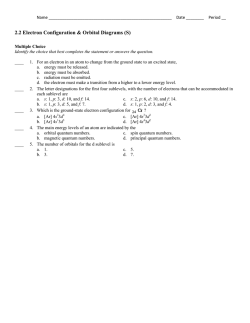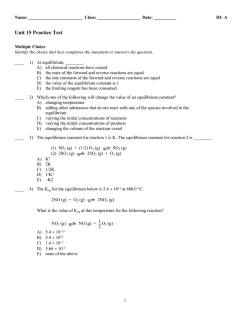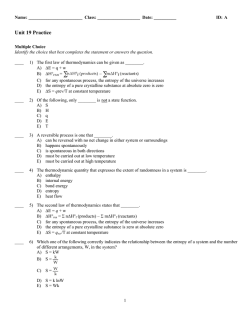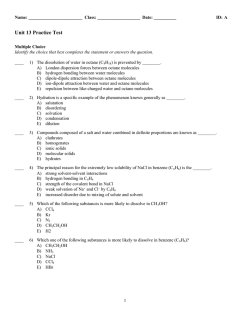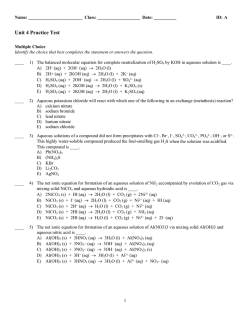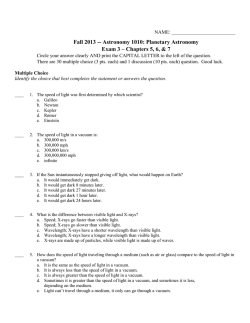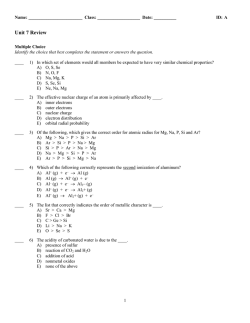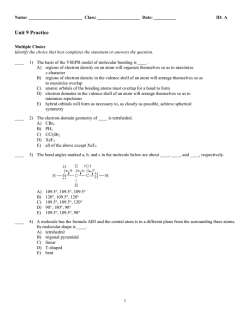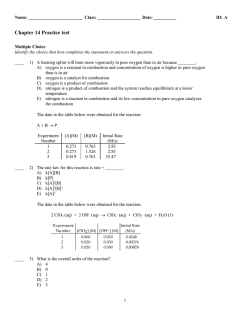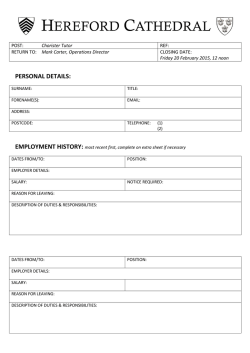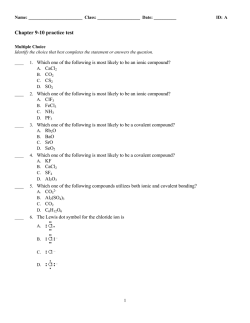
Unit 16 Practice Test
Name: ________________________ Class: ___________________ Date: __________ ID: A Unit 16 Practice Test Multiple Choice Identify the choice that best completes the statement or answers the question. ____ 1) According to the Arrhenius concept, an acid is a substance that ________. A) is capable of donating one or more H + B) causes an increase in the concentration of H+ in aqueous solutions C) can accept a pair of electrons to form a coordinate covalent bond D) reacts with the solvent to form the cation formed by autoionization of that solvent E) tastes bitter ____ 2) A Brnsted-Lowry acid is defined as a substance that ________. A) increases Ka when placed in H2O B) decreases [H+] when placed in H2O C) increases [OH–] when placed in H2O D) acts as a proton acceptor E) acts as a proton donor ____ 3) A substance that is capable of acting as both an acid and as a base is ________. A) autosomal B) conjugated C) ambiprotic D) saturated E) miscible ____ 4) The magnitude of Kw indicates that ________. A) water autoionizes very slowly B) water autoionizes very quickly C) water autoionizes only to a very small extent D) the autoionization of water is exothermic ____ 5) The hydride ion, H –, is a stronger base than the hydroxide ion, OH –. The product(s) of the reaction of hydride ion with water is/are ________. A) H3O+ (aq) B) OH– (aq) + H2 (g) C) OH– (aq) + 2H+ (aq) D) no reaction occurs E) H2O2 (aq) ____ 6) Of the following acids, ________ is not a strong acid. A) HNO2 B) H2SO4 C) HNO3 D) HClO4 E) HCl 1 Name: ________________________ ID: A ____ 7) The Ka of hypochlorous acid (HClO) is 3.0 10–8 at 25 °C. What is the percent ionization of hypochlorous acid in a 0.015 M aqueous solution of HClO at 25 °C? A) 4.5 10–8 B) 14 C) 2.1 10–5 D) 0.14 E) 1.4 10–3 ____ 8) Classify the following compounds as weak acids (W) or strong acids (S): A) B) C) D) E) ____ hypochlorous acid WSS SSS SWW WWW WSW perchloric acid chloric acid 9) HA is a weak acid. Which equilibrium corresponds to the equilibrium constant Kb for A –? A) HA (aq) + H2O (l) H2A+ (aq) + OH–(aq) – + HA (aq) + H2O (l) B) A (aq) + H3O (aq) H2O (l) + H+ (aq) C) HA (aq) + OH– (aq) – HA (aq) + OH– (aq) D) A (aq) + H2O (l) – – E) A (aq) + OH (aq) HOA2– (aq) ____ 10) Classify the following compounds as weak bases (W) or strong bases (S): A) B) C) D) E) ammonia WWS SSS SWW WS S WSW fluoride ion sodium hydroxide ____ 11) Using the data in the table, which of the conjugate bases below is the strongest base? A) B) C) D) E) OAc– CHO2– ClO– F– OAc– and CHO2– 2 Name: ________________________ ID: A ____ 12) Using the data in the table, which of the conjugate acids below is the strongest acid? A) B) C) D) E) HClO HCO3– H2S NH3CH3+ H2S and HClO ____ 13) Using the data in the table, which of the conjugate acids below is the strongest acid? A) B) C) D) E) NH4+ C5H5NH+ H3NOH+ NH3CH3+ NH4+ and NH3CH3+ ____ 14) Which of the following ions will act as a weak base in water? A) OH– B) Cl– C) NO3– D) ClO– E) None of the above will act as a weak base in water. ____ 15) A 0.0035 M aqueous solution of a particular compound has pH = 2.46. The compound is ________. A) a weak base B) a weak acid C) a strong acid D) a strong base E) a salt 3 Name: ________________________ ID: A ____ 16) Of the following substances, an aqueous solution of ________ will form basic solutions. A) B) C) D) E) NH4Cl Cu(NO3)2 NH4Cl, Cu(NO3)2 K2CO3, NH4Cl NaF only NaF, K2CO3 NH4Cl only K2CO3 NaF ____ 17) Of the following, which is the strongest acid? A) HClO B) HClO3 C) HClO2 D) HClO4 E) HIO ____ 18) The conjugate base of HSO4– is ________. A) OH– B) H2SO4 C) SO42– D) HSO4+ E) H3SO4+ ____ 19) The conjugate acid of HSO4– is ________. A) SO42– B) H2SO4 C) HSO4+ D) H+ E) HSO3+ ____ 20) What is the conjugate base of OH–? A) O2 B) O– C) H2O D) O2– E) H3O+ ____ 21) What is the pOH of an aqueous solution at 25.0 °C that contains 3.98 10–9 M hydronium ion? A) 8.400 B) 5.600 C) 9.000 D) 3.980 E) 7.000 4 Name: ________________________ ID: A ____ 22) Calculate the concentration (in M) of hydroxide ions in a solution at 25.0 °C with a pOH of 4.223. A) 5.98 10–5 B) 1.67 10–10 C) 1.67 104 D) 5.99 10–19 E) 1.00 10–7 ____ 23) An aqueous solution contains 0.150 M HCl at 25.0 °C. The pH of the solution is ________. A) 0.150 B) 1.00 C) 13.00 D) 7.00 E) 0.82 ____ 24) The pH of a 0.55 M aqueous solution of hypobromous acid, HBrO, at 25.0 °C is 4.48. What is the value of K a for HBrO? A) 2.0 10–9 B) 1.1 10–9 C) 6.0 10–5 D) 3.3 10–5 E) 3.0 104 ____ 25) The pH of a 0.60 M aqueous solution of formic acid, HCHO 2, at 25.0 °C is 1.98. What is the value of K a for formic acid? A) 2.0 10–5 B) 1.8 10–4 C) 6.0 10–5 D) 3.5 10–4 E) none of the above ____ 26) The Ka of hypochlorous acid (HClO) is 3.00 10–8. What is the pH at 25.0 °C of an aqueous solution that is 0.0200 M in HClO? A) +2.45 B) –2.45 C) –9.22 D) +9.22 E) +4.61 ____ 27) The acid-dissociation constants of sulfurous acid (H 2SO3) are Ka1 = 1.7 10–2 and Ka2 = 6.4 10–8 at 25.0 °C. Calculate the pH of a 0.163 M aqueous solution of sulfurous acid. A) 4.53 B) 1.28 C) 1.86 D) 6.21 E) 1.93 5 Name: ________________________ ID: A ____ 28) The pH of a 0.55 M aqueous solution ammonia, NH 3, at 25.0 °C is 11.50. What is the value of K b for NH3? A) 2.0 10–9 B) 1.1 10–9 C) 6.0 10–5 D) 1.8 10–5 E) none of the above ____ 29) The pH of a 0.10 M solution of a weak base is 9.82. What is the K b for this base? A) 2.1 10–4 B) 4.4 10–8 C) 8.8 10–8 D) 6.6 10–4 E) 2.0 10–5 ____ 30) An aqueous solution contains 0.050 M of methylamine. The concentration of hydroxide ion in this solution is ________ M. K b for methylamine is 4.4 10–4. A) 0.050 B) 2.2 10–5 C) 2.9 10–3 D) 4.5 10–3 E) 4.7 10–3 ____ 31) Ka for HCN is 4.9 10–10. What is the pH of a 0.068 M aqueous solution of sodium cyanide? A) 0.74 B) 2.96 C) 11.07 D) 13.24 E) 7.00 ____ 32) The conjugate base of H2PO4– is ________. A) H3PO4 B) HPO42– C) PO43– D) H3O+ E) OH– ____ 33) Calculate the molarity of hydroxide ion in an aqueous solution that has a pOH of 3.00. A) 1.0 10–3 B) 11.00 C) 1.0 10–11 D) 3.0 10–14 E) 1.1 10–13 ____ 34) What is the pOH of an aqueous solution at 25.0 °C in which [OH –] is 0.0010 M? A) 11.00 B) –3.00 C) 3.00 D) –11.00 E) 6.91 6 Name: ________________________ ID: A ____ 35) Which solution will be the most basic? A) 0.10 M Ba(OH)2 B) 0.10 M KOH C) 0.10 M H2O D) 0.10 M CH3OH E) All solutions have equal basicity. ____ 36) What is the pH of a 0.020 M aqueous solution of barium hydroxide? A) 12.60 B) 12.30 C) 1.70 D) 10.41 E) 1.40 ____ 37) The Ka of hypochlorous acid (HClO) is 3.0 10–8 at 25.0 °C. Calculate the pH of a 0.0385 M hypochlorous acid solution. A) 3.05 B) 9.53 C) 4.47 D) 6.52 E) –3.05 ____ 38) Calculate the pH of a 0.500 M aqueous solution of NH 3. The Kb of NH3 is 1.77 10–5. A) 8.95 B) 11.47 C) 2.53 D) 11.77 E) 2.23 ____ 39) Calculate the pOH of a 0.0727 M aqueous sodium cyanide solution at 25.0 °C. K b for CN– is 4.9 10–10. A) 9.33 B) 10.00 C) 5.22 D) 1.14 E) 8.78 ____ 40) Kb for NH3 is 1.8 10–5. What is the pH of a 0.40 M aqueous solution of NH 4Cl at 25.0 °C? A) 2.57 B) 11.43 C) 9.18 D) 4.82 E) 11.23 ____ 41) The Ka for formic acid (HCO2H) is 1.8 10–4. What is the pH of a 0.20 M aqueous solution of sodium formate (NaHCO2)? A) 11.64 B) 5.48 C) 3.39 D) 8.52 E) 4.26 7 Name: ________________________ ID: A ____ 42) Of the following, which is the weakest acid? A) HPO3– B) H3PO4 C) H2PO4– D) HPO4– E) The acid strength of all of the above is the same. 8 ID: A Unit 16 Practice Test Answer Section MULTIPLE CHOICE 1) ANS: OBJ: 2) ANS: OBJ: 3) ANS: OBJ: 4) ANS: OBJ: 5) ANS: OBJ: 6) ANS: OBJ: 7) ANS: OBJ: 8) ANS: OBJ: 9) ANS: OBJ: 10) ANS: OBJ: 11) ANS: OBJ: 12) ANS: OBJ: 13) ANS: OBJ: 14) ANS: OBJ: 15) ANS: OBJ: 16) ANS: OBJ: 17) ANS: OBJ: 18) ANS: OBJ: 19) ANS: OBJ: 20) ANS: OBJ: 21) ANS: OBJ: B PTS: 16.1; G2 E PTS: 16.2; G2 C PTS: 16.2; G2 C PTS: 16.3; G2 B PTS: 16.5; G2 A PTS: 16.6, 16.7; G2 D PTS: 16.6, 16.7; G2 A PTS: 16.6, 16.7; G2 D PTS: 16.5; G2 A PTS: 16.5; G2 C PTS: 16.8; G2 C PTS: 16.8; G2 B PTS: 16.8; G2 D PTS: 16.9; G2 C PTS: 16.9; G2 D PTS: 16.9; G2 D PTS: 16.1; G2 C PTS: 16.2; G2 B PTS: 16.2; G2 D PTS: 16.2; G2 B PTS: 16.4; G4 1 DIF: 1 REF: Page Ref: 16.1 1 DIF: 1 REF: Page Ref: 16.2 1 DIF: 1 REF: Page Ref: 16.2 1 DIF: 2 REF: Page Ref: 16.3 1 DIF: 3 REF: Page Ref: 16.5 1 DIF: 1 REF: Page Ref: 16.6 1 DIF: 4 REF: Page Ref: 16.6 1 DIF: 3 REF: Page Ref: 16.6 1 DIF: 3 REF: Page Ref: 16.7 1 DIF: 2 REF: Page Ref: 16.7 1 DIF: 3 REF: Page Ref: 16.8 1 DIF: 3 REF: Page Ref: 16.8 1 DIF: 3 REF: Page Ref: 16.8 1 DIF: 3 REF: Page Ref: 16.9 1 DIF: 3 REF: Page Ref: 16.9 1 DIF: 3 REF: Page Ref: 16.9 1 DIF: 3 REF: Page Ref: 16.10 1 DIF: 2 REF: Page Ref: 16.2 1 DIF: 2 REF: Page Ref: 16.2 1 DIF: 2 REF: Page Ref: 16.2 1 DIF: 2 REF: Page Ref: 16.4 1 ID: A 22) ANS: OBJ: 23) ANS: OBJ: 24) ANS: OBJ: 25) ANS: OBJ: 26) ANS: OBJ: 27) ANS: OBJ: 28) ANS: OBJ: 29) ANS: OBJ: 30) ANS: OBJ: 31) ANS: OBJ: 32) ANS: OBJ: 33) ANS: OBJ: 34) ANS: OBJ: 35) ANS: OBJ: 36) ANS: OBJ: 37) ANS: OBJ: 38) ANS: OBJ: 39) ANS: OBJ: 40) ANS: OBJ: 41) ANS: OBJ: 42) ANS: OBJ: A PTS: 16.4; G4 E PTS: 16.5; G4 A PTS: 16.6, 16.7; G4 B PTS: 16.6, 16.7; G4 E PTS: 16.6, 16.7; G4 B PTS: 16.6, 16.7; G4 D PTS: 16.6, 16.7; G4 B PTS: 16.6, 16.7; G4 D PTS: 16.6, 16.7; G4 C PTS: 16.9; G4 A PTS: 16.2; G2 A PTS: 16.4; G4 C PTS: 16.4; G4 A PTS: 16.5; G2 A PTS: 16.5; G4 C PTS: 16.6, 16.7; G4 B PTS: 16.6, 16.7; G4 C PTS: 16.9; G4 D PTS: 16.9; G4 D PTS: 16.9; G4 A PTS: 16.1; G2 1 DIF: 2 REF: Page Ref: 16.4 1 DIF: 3 REF: Page Ref: 16.5 1 DIF: 4 REF: Page Ref: 16.6 1 DIF: 4 REF: Page Ref: 16.6 1 DIF: 4 REF: Page Ref: 16.6 1 DIF: 5 REF: Page Ref: 16.6 1 DIF: 4 REF: Page Ref: 16.7 1 DIF: 4 REF: Page Ref: 16.7 1 DIF: 5 REF: Page Ref: 16.7 1 DIF: 4 REF: Page Ref: 16.9 1 DIF: 4 REF: Page Ref: 16.2 1 DIF: 3 REF: Page Ref: 16.4 1 DIF: 2 REF: Page Ref: 16.4 1 DIF: 4 REF: Page Ref: 16.5 1 DIF: 3 REF: Page Ref: 16.5 1 DIF: 4 REF: Page Ref: 16.6 1 DIF: 3 REF: Page Ref: 16.7 1 DIF: 3 REF: Page Ref: 16.9 1 DIF: 4 REF: Page Ref: 16.9 1 DIF: 4 REF: Page Ref: 16.9 1 DIF: 3 REF: Page Ref: 16.10 2 Unit 16 Practice Test [Answer Strip] D _____ 7) C 12) _____ ID: A D 16) _____ A 22) _____ B _____ 1) E 23) _____ A _____ 8) D 17) _____ E _____ 2) A 24) _____ B 13) _____ C 18) _____ D _____ 9) C _____ 3) B 25) _____ B 19) _____ A 10) _____ C _____ 4) D 14) _____ D 20) _____ B _____ 5) E 26) _____ C 11) _____ C 15) _____ B 21) _____ A _____ 6) B 27) _____ Unit 16 Practice Test [Answer Strip] D 28) _____ A 35) _____ B 29) _____ A 36) _____ D 30) _____ C 37) _____ C 31) _____ A 32) _____ A 33) _____ C 34) _____ B 38) _____ C 39) _____ D 40) _____ D 41) _____ A 42) _____ ID: A
© Copyright 2025
